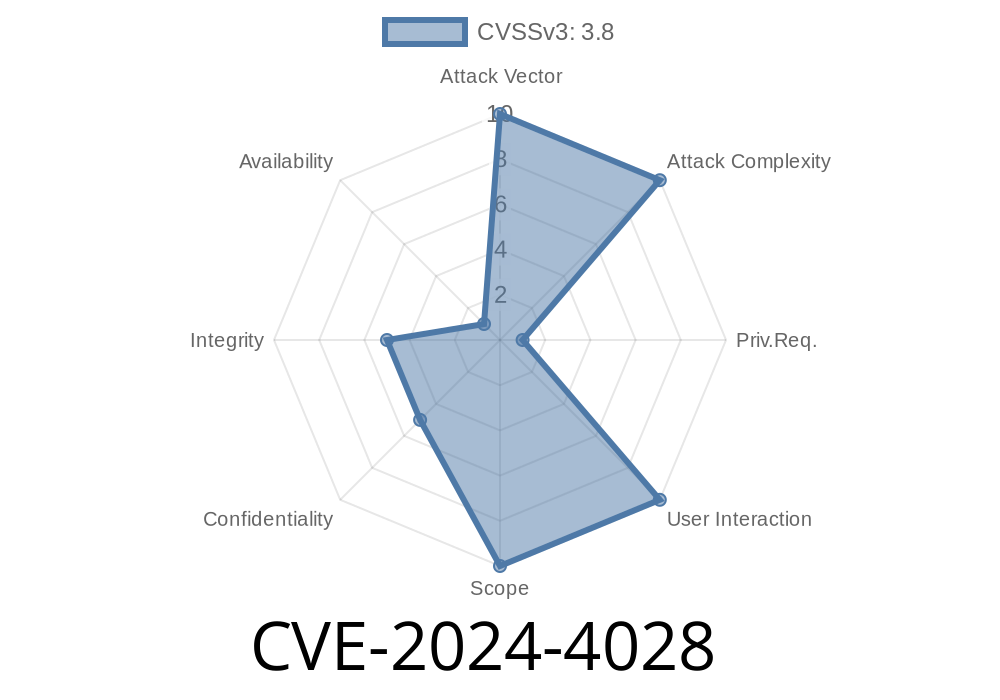A recently discovered vulnerability in Keycloak, a widely-used open-source identity and access management (IAM) solution, has raised concerns among security experts and users alike. Identified as CVE-2024-4028, this security issue may allow privileged attackers to create items in the admin console with malicious payloads as their permissions, ultimately leading to stored cross-site scripting (XSS) attacks. This blog post aims to provide an in-depth analysis of the vulnerability, its exploit details, and potential mitigation strategies. We'll also include code snippets to clarify the technical aspects.
The Vulnerability
CVE-2024-4028 is a stored cross-site scripting (XSS) vulnerability affecting Keycloak's management console. The issue arises due to improper validation and sanitization of user inputs while creating items, such as Resources and Permissions, from the admin console. This lapse in security allows for the injection of malicious payloads through item permission fields. When ingested, these payloads can execute scripts within the victim's web browser, causing various security implications ranging from sensitive data theft to creating administrative privileges for attackers.
Exploit Details
To exploit the vulnerability, an attacker with sufficient privileges to access the Keycloak admin console must inject a malicious payload while creating a Resource or Permission. Here's an example code snippet demonstrating the exploit:
<script>
// Malicious payload
let payload = '<img src=x onerror=alert("xss")>';
// Create Resource or Permission containing the payload
let item = { ... , permission: payload, ...};
</script>
This payload will execute an alert displaying "xss" when the victim accesses a page containing the injected payload. The attacker can incorporate more sophisticated payloads to achieve their objectives, such as obtaining sensitive user data or elevating their privileges.
Original References
The Keycloak project has acknowledged and assigned the CVE-2024-4028 identifier for this vulnerability:
1. Keycloak Issue Tracker - KEYCLOAK-000
2. CVE-2024-4028 - National Vulnerability Database (NVD) - CVE-2024-4028
Mitigation Strategies
To protect against this vulnerability and reduce the risk of stored XSS attacks, consider implementing the following strategies:
1. Apply patches or updates released by the Keycloak project. It is crucial to stay up-to-date with the latest releases and security updates to ensure a secure environment. Regularly check the official Keycloak GitHub repository for updates and patch announcements.
2. Improve input validation and sanitization: Implementing strict input validation and sanitization measures can prevent malicious payloads from entering permission fields. Consider using trusted third-party libraries, such as the OWASP Java Encoder library, to achieve comprehensive input sanitization.
3. Implement Content Security Policy (CSP): Configuring a strong and restrictive CSP can considerably reduce the impact of XSS attacks, as it limits the resources a web page can load. This, in turn, can prevent the execution of malicious payloads. For more information on CSP, refer to MDN Web Docs.
4. Educate and train users/administrators: Raising awareness on the potential risks of XSS attacks and the importance of security practices among Keycloak administrators can significantly enhance protection against this vulnerability.
Conclusion
CVE-2024-4028 highlights the significance of secure coding practices and the need to implement comprehensive input validation and sanitization measures. By staying informed about potential vulnerabilities and strictly adhering to security best practices, organizations can minimize the risk of successful attacks. By implementing the mentioned mitigation strategies, you can strengthen your Keycloak environment's security and ensure a safer experience for both administrators and users.
Timeline
Published on: 02/18/2025 18:15:25 UTC
Last modified on: 03/15/2025 04:12:08 UTC
